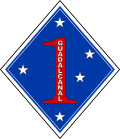United States Army Divisions
The 82nd Airborne Division was originally the 82nd Infantry Division of the Organized Reserve, and after being ordered into active military service on 25 March 1942, was converted to an airborne division on 15 August 1942. The 101st Infantry Division was disbanded in the Organized Reserve on 15 August 1942, and was concurrently reconstituted and activated as an airborne division on the same date.
The 15th Airborne Division was constituted, but never activated. It was dropped from the mobilization program in 1943.
Airborne Divisions
| Airborne Divisions | ||||||
|---|---|---|---|---|---|---|
| Shoulder Sleeve Insignia | Name | Headquarters organized Ordered into active military service or activated | Entered Combat | Days in Combat | Commanding General | Campaigns |
 | 11th Airborne Division [2] | 25 February 1943 | 18 November 1944 | 204 | Maj. Gen. Joseph M. Swing |
|
 | 13th Airborne Division [3] [4] | 13 August 1943 | No combat | - | Maj. Gen. Elbridge G. Chapman | - |
 | 17th Airborne Division [5] [6] | 15 April 1943 | 25 December 1944 | 45 | Maj. Gen. William M. Miley |
|
 | 82nd Airborne Division [7] [8] | 23 September 1921 25 March 1942 | 9 July 1943 | 422 | Maj. Gen. Matthew B. Ridgway Maj. Gen. James M. Gavin |
|
 | 101st Airborne Division [9] [10] | 10 September 1921 15 August 1942 | 6 June 1944 | 214 | Maj. Gen. Maxwell D. Taylor Brig. Gen. Anthony C. McAuliffe Maj. Gen. Maxwell D. Taylor |
|
Armored Divisions
The 19th Armored Division was constituted, but never activated. It was dropped from the mobilization program in 1943.
| Armored Divisions | ||||||
|---|---|---|---|---|---|---|
| Shoulder Sleeve Insignia | Name | Activated | Entered Combat | Days in Combat | Commanding General | Campaigns |
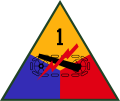 | 1st Armored Division [11] | 15 July 1940 | 8 November 1942 | 360 | Maj. Gen. Orlando Ward Maj. Gen. Ernest N. Harmon Maj. Gen. Vernon E. Prichard |
|
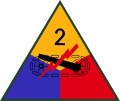 | 2nd Armored Division [12] [13] | 15 July 1940 | 8 November 1942 | 443 | Maj. Gen. Hugh J. Gaffey Maj. Gen. Edward H. Brooks Maj. Gen. Ernest N. Harmon Maj. Gen. Isaac D. White |
|
 | 3rd Armored Division [14] [15] | 15 April 1941 | 9 July 1944 | 231 | Maj. Gen. Leroy H. Watson Maj. Gen. Maurice Rose (KIA) Brig. Gen. Doyle O. Hickey |
|
 | 4th Armored Division [16] [17] | 15 April 1941 | 28 July 1944 | 230 | Maj. Gen. John S. Wood Maj. Gen. Hugh J. Gaffey Col. Walter A. Bigby Brig. Gen. Holmes E. Dager Maj. Gen. Hugh J. Gaffey Maj. Gen. William M. Hoge |
|
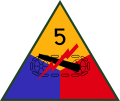 | 5th Armored Division [18] [19] | 10 October 1941 | 2 August 1944 | 161 | Maj. Gen. Lunsford E. Oliver |
|
 | 6th Armored Division [20] [21] | 15 February 1942 | 28 July 1944 | 272 | Maj. Gen. Robert W. Grow Brig. Gen. George W. Read Jr. |
|
 | 7th Armored Division [22] [23] | 1 March 1942 | 14 August 1944 | 172 | Maj. Gen. Lindsay M. Silvester Maj. Gen. Robert W. Hasbrouck |
|
 | 8th Armored Division [24] [25] | 1 April 1942 | 23 February 1945 | 63 | Maj. Gen. John M. Devine |
|
 | 9th Armored Division [26] [27] | 15 July 1942 | 16 December 1944 | 91 | Maj. Gen. John W. Leonard |
|
 | 10th Armored Division [28] [29] | 15 July 1942 | 1 November 1944 | 124 | Maj. Gen. William H. H. Morris Jr. |
|
 | 11th Armored Division [30] [31] | 15 August 1942 | 23 December 1944 | 96 | Brig. Gen. Charles S. Kilburn Maj. Gen. Holmes E. Dager |
|
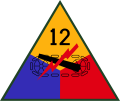 | 12th Armored Division [32] [33] | 15 September 1942 | 7 December 1944 | 102 | Maj. Gen. Roderick R. Allen |
|
 | 13th Armored Division [34] [35] | 15 October 1942 | 10 April 1945 | 16 | Maj. Gen. John B. Wogan Maj. Gen. John Millikin |
|
 | 14th Armored Division [36] [37] | 15 November 1942 | 20 November 1944 | 167 | Maj. Gen. Albert C. Smith |
|
 | 16th Armored Division [38] [39] | 15 July 1943 | 5 May 1945 | 3 | Brig. Gen. John L. Pierce |
|
 | 20th Armored Division [40] [41] | 15 March 1943 | 24 April 1945 | 8 | Maj. Gen. Orlando Ward |
|
Cavalry Divisions
| Cavalry Divisions | ||||||
|---|---|---|---|---|---|---|
| Shoulder Sleeve Insignia | Name | Activated | Entered Combat | Days in Combat | Commanding General | Campaigns |
 | 1st Cavalry Division [42] | 31 August 1921 | 29 February 1944 | 521 | Maj. Gen. Verne D. Mudge Brig. Gen. Hugh F. T. Hoffman Maj. Gen. William C. Chase |
|
 | 2nd Cavalry Division [43] | 1 April 1941 25 February 1943 as segregated division | No combat | - | Brig. Gen. Terry de la Mesa Allen Sr. Brig. Gen. John Millikin Brig. Gen. John B. Coulter Maj. Gen. Harry H. Johnson | 1st inactivation: 15 July 1942 2nd inactivation: 10 May 1944 |
Infantry Divisions
1st to 25th
Infantry divisions were initially titled with their numerical designation and "division" (e.g., "1st Division"). In August 1941, the War Department issued a statement that divisions' names were to represent their major arm of service (i.e., armored, cavalry, or infantry) to avoid confusion as several divisions of different arms now shared the same number. Some divisions issued general orders introducing "infantry" as an official part of their names, but this change was not added to the table of organization of the infantry division, which technically controlled its naming conventions, until 1 August 1942. [44]
The 1st through 25th Infantry Divisions, excepting the 10th Mountain Division, were raised in the Regular Army or the Army of the United States prior to American involvement in World War II. Because of funding cuts, in September 1921, the 4th through 9th Infantry Divisions were mostly inactivated. Within a few years, the headquarters of the 1st and 3rd Infantry Divisions "almost ceased to exist. Only the division commander and a few staff officers remained to carry out minimal division administrative functions, and neither division exercised true command functions over their units." The 2nd Infantry Division remained the most functional stateside division, as it was concentrated entirely at Fort Sam Houston, Texas. By the mid-1920s, most of the divisions' inactive units were staffed with Organized Reserve officers as "Regular Army Inactive" units.
The Hawaiian Division, "which was the closest thing to a full-strength division in the interwar American Army." was split on 1 October 1941 to create the 24th and 25th Infantry Divisions. The 24th Infantry Division headquarters inherited the lineage of the Hawaiian Division's headquarters, while the 25th Infantry Division was raised in the Army of the United States.
The 10th Mountain Division was raised in the Army of the United States in 1943.
| Infantry Divisions | ||||||
|---|---|---|---|---|---|---|
| Shoulder Sleeve Insignia | Name | Activated | Entered Combat | Days in Combat | Commanding General | Campaigns |
 | 1st Infantry Division [45] [46] | 17 May 1917 | 8 November 1942 | 443 | Maj. Gen. Terry de la Mesa Allen Sr. Maj. Gen. Clarence R. Huebner Maj. Gen. Clift Andrus |
|
 | 2nd Infantry Division [47] [48] | 26 October 1917 | 12 June 1944 | 303 | Maj. Gen. Walter M. Robertson |
|
 | 3rd Infantry Division [49] [50] | 12 November 1917 | 8 November 1942 | 536 | Maj. Gen. Jonathan W. Anderson Maj. Gen. Lucian K. Truscott Jr. Maj. Gen. John W. O'Daniel |
|
 | 4th Infantry Division [52] [53] | 10 December 1917 3 June 1940 | 6 June 1944 | 299 | Maj. Gen. Raymond O. Barton Maj. Gen. Harold R. Bull Brig. Gen. James A. Van Fleet Maj. Gen. Harold W. Blakeley |
|
 | 5th Infantry Division [54] [55] | 11 December 1917 2 October 1939 | 16 July 1944 | 270 | Maj. Gen. Stafford LeRoy Irwin Maj. Gen. Albert E. Brown |
|
 | 6th Infantry Division [56] | November 1917 12 October 1939 | 14 June 1944 | 306 | Maj. Gen. Franklin C. Sibert Maj. Gen. Edwin D. Patrick (KIA) Maj. Gen. Charles E. Hurdis |
|
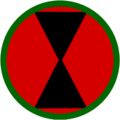 | 7th Infantry Division [57] | 6 December 1917 1 July 1940 | 11 May 1943 | 208 | Maj. Gen. Eugene M. Landrum Maj. Gen. Archibald V. Arnold Maj. Gen. Charles H. Corlett |
|
 | 8th Infantry Division [58] [59] | January 1918 1 July 1940 | 8 July 1944 | 266 | Maj. Gen. William C. McMahon Maj. Gen. Donald A. Stroh Maj. Gen. William G. Weaver Maj. Gen. Bryant E. Moore |
|
 | 9th Infantry Division [60] [61] | 18 July 1918 1 August 1940 | 8 November 1942 | 304 | Maj. Gen. Manton S. Eddy Maj. Gen. Louis A. Craig |
|
 | 10th Mountain Division [62] | 15 July 1943 | 8 January 1945 | 114 | Maj. Gen. George P. Hays |
|
 | 11th Infantry Division | 1918 1941 (phantom in WWII) | Did not see combat | – | – | – |
 | 24th Infantry Division [63] | 25 February 1921 (as Hawaiian Division) 1 October 1941 (as 24th Infantry Division) | 7 December 1941 (22 April 1944 was the first offensive action of the division) | 210 | Maj. Gen. Frederick A. Irving Maj. Gen. Roscoe B. Woodruff |
|
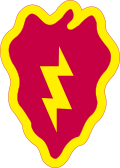 | 25th Infantry Division [65] | 1 October 1941 | 7 December 1941 (10 January 1943 was the first offensive action of the Division) | 165 (consecutive days; exact unknown) | Maj. Gen. J. Lawton Collins Maj. Gen. Charles L. Mullins Jr. |
|
26th to 45th
The 26th through 45th Divisions, with the exception of the 39th and 42nd Divisions, were raised in the National Guard during and after World War I. In postwar mobilization plans, the 26th through 45th Divisions, less two, were allotted to the National Guard. The 30th, 31st, and 39th Divisions had been organized in what would become the states of the Fourth Corps Area; the designations of the 30th and 39th Divisions were originally selected, with the 31st Division being deleted. In 1923, the adjutants general of the states concerned successfully requested that the War Department change the designation of the 39th Division to the 31st Division and adjust allotments of units accordingly. The 42nd Division was the second division deleted from the mobilization program as it had contained units from twenty-six states and the District of Columbia, although it would be reconstituted during the war as a division in the Army of the United States. [67]
| Infantry Divisions | ||||||
|---|---|---|---|---|---|---|
| Shoulder Sleeve Insignia | Name (National Guard units from) | Headquarters organized Ordered into federal service | Entered Combat | Days in Combat | Commanding General | Campaigns |
 | 26th Infantry Division (Massachusetts) [68] [69] [70] | 21 March 1923 16 January 1941 | 12 October 1944 | 210 | Maj. Gen. Willard S. Paul |
|
 | 27th Infantry Division (New York) [68] [71] | 23 December 1921 15 October 1940 | 21 November 1943 | 110 | Maj. Gen. Ralph C. Smith Maj. Gen. George W. Griner Jr. |
|
 | 28th Infantry Division (Pennsylvania) [68] [72] [73] | 22 December 1921 17 February 1941 | 27 July 1944 | 196 | Maj. Gen. Lloyd D. Brown Brig. Gen. James E. Wharton (KIA) Maj. Gen. Norman D. Cota |
|
 | 29th Infantry Division (District of Columbia, Maryland, Pennsylvania, and Virginia) [68] [74] [75] | 31 July 1923 3 February 1941 | 6 June 1944 | 242 | Maj. Gen. Charles H. Gerhardt |
|
 | 30th Infantry Division (Georgia, North Carolina, South Carolina, and Tennessee) [68] [76] [77] | 24 August 1926 16 September 1940 | 15 July 1944 | 282 | Maj. Gen. Leland S. Hobbs |
|
 | 31st Infantry Division (Alabama, Florida, Louisiana, and Mississippi) [68] [78] | 15 October 1924 25 November 1940 | 3 July 1944 | 245 | Maj. Gen. John C. Persons Maj. Gen. Clarence A. Martin |
|
 | 32nd Infantry Division (Michigan and Wisconsin) [68] [79] | 24 July 1924 15 October 1940 | 2 October 1942 | 654 | Maj. Gen. Edwin F. Harding Maj. Gen. William H. Gill |
|
 | 33rd Infantry Division (Illinois) [68] [81] | 13 December 1923 5 March 1941 | 1 September 1944 | 139 | Maj. Gen. Percy W. Clarkson |
|
 | 34th Infantry Division (Iowa, Minnesota, North Dakota, and South Dakota) [68] [82] | 14 July 1924 10 February 1941 | 8 November 1942 | 517 (Some elements credited with over 600) | Maj. Gen. Charles W. Ryder Maj. Gen. Charles L. Bolte |
|
 | 35th Infantry Division (Kansas, Missouri, and Nebraska) [68] [83] [84] | 13 September 1935 23 December 1940 | 11 July 1944 | 264 | Maj. Gen. Paul W. Baade |
|
 | 36th Infantry Division (Texas) [68] [85] [86] | 2 May 1923 25 November 1940 | 9 September 1943 | 400 | Maj. Gen. Fred L. Walker Maj. Gen. John E. Dahlquist |
|
 | 37th Infantry Division (Ohio) [68] [87] | 31 May 1923 15 October 1940 | 5 July 1943 | 592 | Maj. Gen. Robert S. Beightler |
|
 | 38th Infantry Division (Indiana, Kentucky, and West Virginia) [68] [88] | 16 March 1923 17 January 1941 | 11 July 1944 | 210 | Maj. Gen. Henry L. C. Jones Maj. Gen. William C. Chase Maj. Gen. Frederick A. Irving |
|
 | 40th Infantry Division (California, Nevada, and Utah) [68] [90] | 18 June 1926 3 March 1941 | 24 April 1944 | 265 | Maj. Gen. Rapp Brush Maj. Gen. Donald J. Myers |
|
| 41st Infantry Division (Idaho, Montana, Oregon, Washington, and Wyoming) [68] [91] | 3 January 1930 16 September 1940 | 2 January 1943 | 380 | Maj. Gen. Horace H. Fuller Maj. Gen. Jens A. Doe |
| |
 | 42nd Infantry Division (The 42nd Infantry Division was a reconstitution of the National Guard's 42nd Division that had fought in World War I, but was raised in the Army of the United States rather than in the National Guard) [92] [93] | 14 July 1943 | 24 January 1944 | 106 | Maj. Gen. Harry J. Collins |
|
 | 43rd Infantry Division (Connecticut, Maine, Rhode Island, and Vermont) [68] [94] | 21 March 1925 24 February 1941 | 17 February 1943 | 370 | Maj. Gen. John H. Hester Maj. Gen. Leonard F. Wing |
|
 | 44th Infantry Division (Delaware, New Jersey, and New York) [68] [95] [96] | 26 March 1924 16 September 1940 | 24 October 1944 | 190 | Maj. Gen. Robert L. Spragins Maj. Gen. William F. Dean |
|
 | 45th Infantry Division (Arizona, Colorado, New Mexico, and Oklahoma) [68] [97] [98] | 3 August 1923 16 September 1940 | 10 July 1943 | 511 | Maj. Gen. William W. Eagles Maj. Gen. Robert T. Frederick |
|
 | Americal Division (Composite task force later reorganized as a division) [68] [99] | 27 May 1942 | 13 October 1942 | 600 | Maj. Gen. Alexander M. Patch Maj. Gen. John R. Hodge Maj. Gen. Robert B. McClure Maj. Gen. William H. Arnold |
|
63rd to 89th
After World War I, 33 infantry divisions (the 76th through 104th) were organized as part of the Organized Reserve. They were nominally regional organizations, drawing their officer cadre and a small, nearly insignificant, number of enlisted men from an allotted portion of a state, entire state, or multiple states, similar to National Guard units. Prior to American involvement in World War II, Organized Reserve officers were called to active duty individually and assigned to existing Regular Army and National Guard units. When the Organized Reserve units themselves were called to active duty beginning in 1942, "few of the Reserve officers originally assigned to...units were available for duty with them. Consequently, the units as activated bore small resemblance to those of peacetime." [100]
The 61st, 62nd, 67th, 68th, and 72nd-74th Infantry Divisions were constituted, but never activated. They were dropped from the mobilization program in 1943.
| Infantry Divisions | ||||||
|---|---|---|---|---|---|---|
| Shoulder Sleeve Insignia | Name | Headquarters organized Ordered into active military service or activated | Entered Combat | Days in Combat | Commanding General | Campaigns |
 | 63rd Infantry Division [101] [102] | 15 June 1943 | 22 December 1944 | 119 | Maj. Gen. Louis E. Hibbs |
|
 | 65th Infantry Division [103] [104] | 16 August 1943 | 9 March 1945 | 55 | Maj. Gen. Stanley E. Reinhart |
|
 | 66th Infantry Division [105] [106] | 15 April 1943 | 1 January 1945 | 91 | Maj. Gen. Herman F. Kramer |
|
 | 69th Infantry Division [107] [108] | 15 May 1943 | 11 February 1945 | 86 | Maj. Gen. Emil F. Reinhardt |
|
 | 70th Infantry Division [109] [110] | 15 June 1943 | 3 February 1945 | 83 | Maj. Gen. Allison J. Barnett |
|
 | 71st Infantry Division [111] [112] | 15 July 1943 | 12 March 1945 | 62 | Maj. Gen. Willard G. Wyman |
|
 | 75th Infantry Division [113] [114] | 15 April 1943 | 25 December 1944 | 94 | Maj. Gen. Fay B. Prickett Maj. Gen. Ray E. Porter |
|
 | 76th Infantry Division [115] [116] | 1 September 1921 15 June 1942 | 19 January 1945 | 107 | Maj. Gen. William R. Schmidt |
|
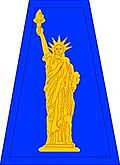 | 77th Infantry Division [117] | 1 July 1921 25 March 1942 | 21 July 1944 | 208 | Maj. Gen. Andrew D. Bruce |
|
| 78th Infantry Division [118] [119] | 1 July 1921 15 August 1942 | 13 December 1944 | 125 | Maj. Gen. Edwin P. Parker Jr. |
| |
 | 79th Infantry Division [120] [121] | 29 September 1921 15 June 1942 | 19 June 1944 | 248 | Maj. Gen. Ira T. Wyche |
|
 | 80th Infantry Division [122] [123] | 1 September 1921 15 July 1942 | 8 August 1944 | 289 | Maj. Gen. Horace L. McBride |
|
 | 81st Infantry Division [124] | 23 September 1921 15 June 1942 | 17 September 1944 | 166 | Maj. Gen. Paul J. Mueller |
|
 | 83rd Infantry Division [125] [126] | 27 September 1921 15 August 1942 | 27 June 1944 | 244 | Maj. Gen. Robert C. Macon |
|
 | 84th Infantry Division [127] [128] | 6 September 1921 15 October 1942 | 18 November 1944 | 170 | Maj. Gen. Alexander R. Bolling |
|
 | 85th Infantry Division [129] | 10 September 1921 15 May 1942 | 10 April 1944 | 260 | Maj. Gen. John B. Coulter |
|
 | 86th Infantry Division [130] [131] | 10 September 1921 15 December 1942 | 29 March 1945 | 34 | Maj. Gen. Harris M. Melasky |
|
 | 87th Infantry Division [132] [133] | 23 September 1921 15 December 1942 | 13 December 1944 | 134 | Maj. Gen. Frank L. Culin Jr. |
|
 | 88th Infantry Division [134] | 2 September 1921 15 July 1942 | 3 January 1944 | 307 | Maj. Gen. John E. Sloan Maj. Gen. Paul W. Kendall |
|
 | 89th Infantry Division [135] [136] | 2 September 1921 15 July 1942 | 12 March 1945 | 57 | Maj. Gen. Thomas D. Finley |
|
90th to 106th
The 105th and 107th Infantry Divisions were constituted, but never activated. They were intended as additional segregated African American divisions. They were dropped from the mobilization program in 1943.
| Infantry Divisions | ||||||
|---|---|---|---|---|---|---|
| Shoulder Sleeve Insignia | Name | Activated | Entered Combat | Days in Combat | Commanding General | Campaigns |
 | 90th Infantry Division [137] [138] | 8 August 1921 25 March 1942 | 6 June 1944 | 307 | Brig. Gen. Jay W. MacKelvie Maj. Gen. Eugene M. Landrum Maj. Gen. Raymond S. McLain Maj. Gen. James A. Van Fleet Maj. Gen. Lowell Ward Rooks Maj. Gen. Herbert L. Earnest |
|
 | 91st Infantry Division [139] | November 1921 15 August 1942 | 12 July 1944 | 271 | Maj. Gen. William G. Livesay |
|
 | 92nd Infantry Division (Segregated division) [140] | 15 October 1942 | 24 August 1944 | 200 | Maj. Gen. Edward M. Almond |
|
 | 93rd Infantry Division (Segregated division) [141] | 15 May 1942 | 30 March 1944 | 133 | Maj. Gen. Raymond G. Lehman Maj. Gen. Harry H. Johnson |
|
 | 94th Infantry Division [142] [143] | November 1921 15 September 1942 | 17 September 1944 | 209 | Maj. Gen. Harry J. Malony |
|
 | 95th Infantry Division [144] [145] | 31 August 1921 15 July 1942 | 20 October 1944 | 151 | Maj. Gen. Harry L. Twaddle |
|
 | 96th Infantry Division [146] | 7 October 1921 15 August 1942 | 20 October 1944 | 200 | Maj. Gen. James L. Bradley |
|
 | 97th Infantry Division [147] [148] | December 1921 25 February 1943 | 1 April 1945 | 41 | Maj. Gen. Milton B. Halsey |
|
 | 98th Infantry Division [149] | 18 August 1921 15 September 1942 | No combat | - | Maj. Gen. George W. Griner Jr. Maj. Gen. Ralph C. Smith | - |
 | 99th Infantry Division [150] [151] | November 1921 15 November 1942 | 9 November 1944 | 151 | Maj. Gen. Walter E. Lauer |
|
 | 100th Infantry Division [152] [153] | 27 September 1921 15 November 1942 | 9 November 1944 | 163 | Maj. Gen. Withers A. Burress |
|
 | 102nd Infantry Division [154] [155] | 2 September 1921 15 September 1942 | 26 November 1944 | 173 | Maj. Gen. Frank A. Keating |
|
 | 103rd Infantry Division [156] [157] | 31 August 1921 15 November 1942 | 11 November 1944 | 147 | Maj. Gen. Charles C. Hoffner Jr. Maj. Gen. Anthony C. McAuliffe |
|
 | 104th Infantry Division [158] [159] | 7 October 1921 15 September 1942 | 24 October 1944 | 200 | Maj. Gen. Terry de la Mesa Allen Sr. |
|
 | 106th Infantry Division [160] [161] | 15 March 1943 | 10 December 1944 | 63 | Maj. Gen. Alan W. Jones Brig. Gen. Herbert T. Perrin Maj. Gen. Donald A. Stroh |
|
 | Philippine Division [162] | 8 June 1921 | 8 December 1941 | 124 | Maj. Gen. Jonathan M. Wainwright Brig. Gen. Maxon S. Lough |
|


